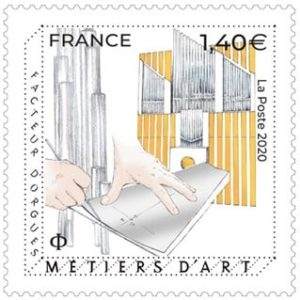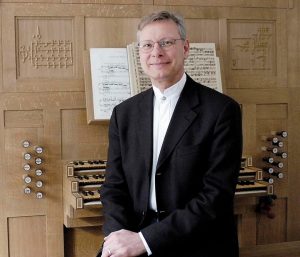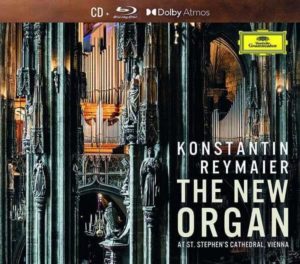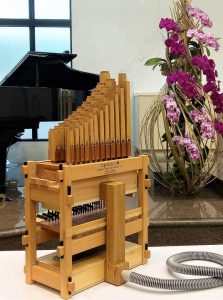請放慢呼吸,感覺空氣從你的鼻子穿過,進入喉嚨,再通到肺部。然後,請以一口氣唱出最長的一個音。你剛才吸入的空氣已經走過完整的旅程:從你的體外,穿過你的身體,然後再送出來。你的長音撐了幾秒鐘呢?如果你設法從肺部擠出更多空氣,可以唱得更長嗎?假如你的肺部更大,足以讓你一口氣唱10分鐘都不必換氣,你可以想像這會是怎樣的感覺嗎?
管風琴在很多方面是與你相似的。它就像是一個巨人在唱歌,又更像是很多人一起唱歌。無論你想像的是獨唱家或合唱團,都跟你唱歌的情形很像,會先吸入空氣,然後讓空氣通過音管來發出聲音。因為它發出的聲音非常活靈活現,管風琴家就說這些音管是在「講話」,而當管風琴發出特別美妙的音樂時,我們就說它在「唱歌」。所以你可以用管風琴的聲音跟你自己的聲音做對照。
你有左右肺葉,管風琴則有一些零件會把氣流帶入,為這座琴賦予生命。它也像你的肺葉一樣,必須運用氣壓才能發出聲音。我們身上有一些與呼吸有關的器官,稱為呼吸系統,會幫助我們呼吸。當中有一些器官是我們熟知的,包括:鼻子、嘴巴、喉嚨、肺臟等。管風琴也有一些零件引入空氣和送出空氣,就像你的鼻子和嘴巴;還有一些零件用來儲存空氣,或是讓空氣通過,就像空氣會穿過你的身體。雖然無法完全用人的身體來比喻,但我們可以先以鼻子開始解說。
我們通常沒有意識到自己是用鼻子吸氣,這是一種自然的動作。而對於管風琴,我們必須選擇讓它開始呼吸。有兩種方法可用,一新一舊。在管風琴漫長的歷史當中,始終需要有一個人把空氣送進管風琴裡,來幫助管風琴師。他鼓動一組大型風箱,提供足夠的空氣給管風琴師,讓他可以彈奏幾分鐘。有些風箱是用手操作,也有些要用腳操作。若沒有鼓風員這樣的助手,管風琴就沒有空氣、沒有氣流,於是無法彈奏。我們對於鼓風員的認識並不是很多,但可想而知他們的身材一定很健壯,因為大部分的風箱會需要很大的力氣才有辦法持續鼓風。事實上,十八世紀和十九世紀製作的大型管風琴,有些具有好幾個大型風箱,一定會需要幾位鼓風員的協助。有些大城市或大教堂裡的音樂學校,鼓風員可能是音樂系學生或是合唱團成員、年輕的管風琴師等,這些人都是演奏管風琴不可或缺的人力(附圖1)。
鼓風員如此重要,卻隱身在看不見的地方,你會覺得很意外吧!當然,這些人只在擔任鼓風工作時才不會被人看見,因為管風琴的風箱通常是藏起來的,可能是在管風琴的後側或旁邊,或者在另一個房間。這表示管風琴師和鼓風員會看不見彼此,所以需要另有溝通方法。而管風琴建造家很樂於解決問題,最早的建造者使用的方法是在管風琴上加裝一個長型把手的小鈴鐺,當管風琴師拉下這個把手,鼓風員身邊的鈴鐺就會發出叮噹聲,告訴鼓風員該開始鼓風了。用小鈴鐺這樣的迷你型樂器,輔助管風琴這種大型樂器的彈奏,是不是很妙?即使在今天,有些舊式管風琴還是使用這種小鈴鐺,在聆聽管風琴演奏時還可聽到輕柔的鈴鐺聲,非常有意思。
風箱曾經是管風琴最大又最重的零件。管風琴愈大,風箱也愈大。風箱是由實木外框和獸皮做成的,獸皮讓它們可以擴張和收縮。風箱上下移動時,有點像是人在呼吸時胸部有起有伏。當然,所有管樂器例如長笛、雙簧管和小號,都會面對一個挑戰,就是從頭到尾不斷需要氣流。管風琴又特別需要空氣,因為有許多音管需要有氣流填入。因為管風琴需要大量空氣,比較後期的建造者就加上另一種箱體,也就是儲風箱,把鼓風器送來的氣流儲存起來,等候管風琴師加以使用,例如拉起更多音栓或彈奏更多音符(附圖2)。
你還記得可以用兩種方法讓管風琴開始呼吸嗎?舊式的方法是雇用一個鼓風員,而新式的方法發明於一百多年前,是用機器代替鼓風員。現今的管風琴會有一個電動風機,提供無限的氣流到管風琴裡,只要把開關打開就可以有氣流,而且從頭到尾壓力都相同。目前大部分的舊式管風琴都已經更新為包含一個送風機,所以不需要鼓風員(附圖3)。
不管用人或機器為風箱鼓風,風箱送出的氣流一定要穿過長長的木製管道,通往設立音管的盒子。這個管道或風槽讓管風琴的肺部(風箱)和聲音(音管)連結起來,所以風槽就像你的喉嚨一樣。風槽的另一端連結的是管風琴的盒狀風櫃。風櫃和風箱就是管風琴最大又最重的零件,也是最複雜的部分,在設計上有幾種不同的方式。風櫃接收從風槽送來的氣流,將之送到音管。當然,並非所有音管都同時發出聲音,所以風櫃的設計會連著托盤,就像是音管底部的小型活塞,打開時可以讓氣流進入,音管就發出聲音(附圖4+5)。
而空氣從管風琴外面流到管風琴裡面再送出去的旅程還沒結束喔,因為音管裡的氣流會一分為二,其中一股氣流會經過音管的開口,另一股氣流則在音管內發出振動。當氣流離開音管,就會回到外面,然後可以再次被送進管風琴裡面,發出更多音樂。氣流經過這一大圈的旅程,就像我們所呼吸的空氣一樣,所以管風琴的呼吸和人很類似,這個呼吸為管風琴賦予生命,管風琴師就是藉著控制氣流來彈奏音樂。
你的朋友蔣士挺
〜The Wind’s Journey〜
Take a slow breath. Feel the air move through your nose, into your throat, and down to your lungs. Then sing the longest note you can before you need another breath. The air you breathed has now completed its journey from outside of you, through your body and back out again. How many seconds did you sing before you ran out of air? Could you sing longer if you squeezed the air out of your lungs? What if your lungs were bigger, maybe even large enough that you could sing for 10 minutes without taking a second breath? Can you imagine how that would feel?
In many ways, the organ resembles you. It’s like a giant singer, or better yet, like many people singing together. But whether you imagine a soloist or a choir, the organ still sings like you, by taking in air and then sending it through the pipes to create sound. The sound that comes out is so alive, organists say the pipes ‘speak’. And when an organ produces an especially beautiful sound, we say it ‘sings’. And there you have a lovely comparison of the organ’s sound to the sound of your own voice.
Much like your own lungs, the organ has parts that draw air inside itself, bringing it to life. And also like your lungs, the organ must use air pressure to make sound. All those body parts connected to breathing, our respiratory system, help us to breathe. Some parts of the respiratory system we all know, including the nose and mouth, throat and lungs. The organ also has parts that take in and let out air, like your nose and mouth, and still other parts that store or move air through the instrument, just like air travels through you. Even though we can’t make a perfect comparison to the body, we can still try by starting with the nose.
Usually, we breathe in through our noses without thinking about it. It’s an automatic action. With the organ, though, we must choose to make it start breathing. There are two ways to do this, one old and one new. For most of its long history, a person was needed to pump air into the organ. This person assisted the organist by pumping a set of large bellows that supplied enough air for the organist to play for several minutes. Some bellows were operated by hand and others by foot. Without this assistant, called a calcant, the organ had no air, no wind, and so the organist couldn’t play. We don’t know much about the people who worked as calcants, but we can guess that they must have been fairly strong, since most bellows required a lot of effort to work continuously. In fact, some of the largest organs from the 18th and 19th centuries, with their multiple large bellows, must have needed a few calcants. In places with music schools, such as large cities or churches, calcants may have been music students, perhaps singers from the choir or young organists. Either way, these people were essential to the business of playing the organ.
Given their importance, it may surprise you to know that calcants were invisible! Of course, people could see them, but not when they were working, because the bellows of an organ is usually hidden, either behind or to the side of the instrument, or even in another room. This meant that the organist and the calcant couldn’t see each other, so they needed another way to communicate. Since organ builders enjoy solving problems, the earliest builders answered this communication question by adding a small bell with a long handle to the organ. When the organist pulled the handle, the bell near the calcant would tinkle, telling the calcant it was time to begin pumping the bellows. Isn’t it fascinating that a tiny musical instrument, that little bell, was needed to help play a giant instrument, the organ? Even today some old organs still have this kind of bell, and hearing its gentle voice adds a bit of joy when listening to the organ.
The bellows used to be one of the largest and heaviest parts of an organ; the larger the organ, the bigger its bellows. Bellows were built with a solid wooden frame and leather folds that allowed them to expand and contract. Watching the bellows moving up and down is a little like seeing a person’s chest rise and fall when they breathe. Of course, the challenge with any wind instrument — like flutes, oboes or trumpets — is that they always need more air. The organ is especially greedy for wind because there are so many pipes for the air to feed. Because organs need a lot of air, some more recent builders have added another kind of box, the reservoir, where air from the bellows can be stored while waiting for the organist to use more wind, either by pulling more stops or playing more notes.
Do you remember that there are two ways to start an organ breathing? The old way was to hire a calcant, but the new way, invented more than a 100 years ago, is to replace the person with a machine. Organs today are built with an electric blower that supplies unlimited wind to the instrument for as long as it is turned on, and always at the same pressure. By now, most old organs have been updated to include a blower so that a calcant is not needed.
Whether a person or a machine pumps the bellows, though, the wind from the bellows must travel through long wooden tunnels to reach the box where the pipes stand. This tunnel, or wind trunk, connects the organ’s lungs (the bellows) with its voice (the pipes), so a wind trunk acts like your throat. At the other end, the trunk connects to the box-shaped wind chests of the organ. Along with the bellows, wind chests are some of the largest and heaviest parts of an organ. They are also the most complex part, and can be designed in several different ways. Wind chests take the air from the wind trunk and direct it to the pipes. Of course, not all of the pipes will speak at once, so the wind chest is designed with pallets, which are little doors opening under the pipes to let the wind rush in, making the pipes speak.
But even this is not quite the end of the wind’s journey from outside the organ, to inside and back out again, because the wind inside a pipe gets divided into two streams. One of them passes out through the mouth of the pipe while the other vibrates inside the pipe. Once the air has left a pipe, though, it finally returns to the outside, where it might again be pumped back into the organ to make more music. The wind journeys in a giant loop, just like the air we breathe, meaning the organ breathe like us. That breath brings the organ to life, and playing with that wind the organist makes music!
Your Friend,
Justin





